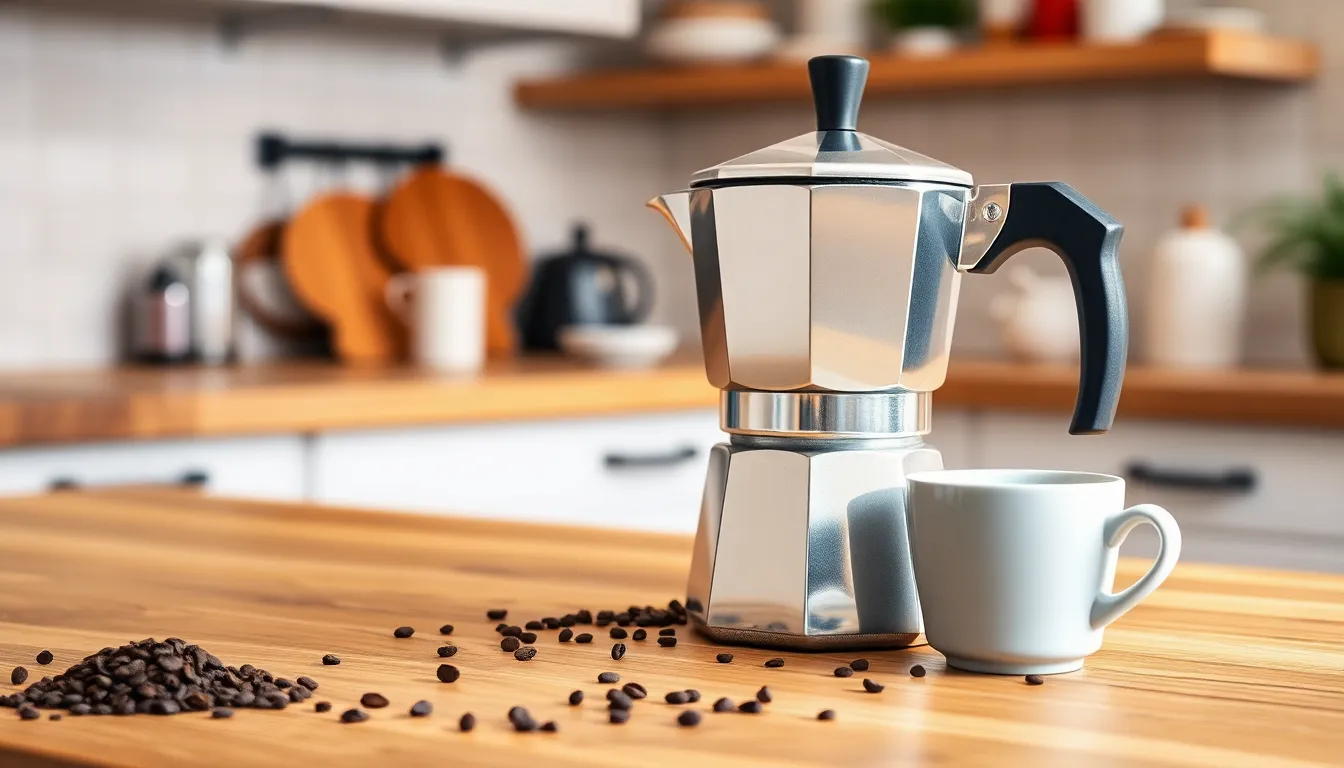Can you put your Moka pot in the dishwasher? It’s a question many coffee enthusiasts face when cleaning their beloved stovetop espresso maker. The answer isn’t as straightforward as you might hope.
Moka pots have become a staple in homes worldwide for brewing rich, flavorful coffee. But, proper maintenance is crucial for longevity and taste quality. While cleaning might seem simple, the dishwasher debate divides coffee lovers – some swear it’s perfectly safe, while others insist it ruins these classic brewers. Understanding the right cleaning approach can protect your investment and ensure your morning brew remains perfect.
What Is a Moka Pot and How Does It Work
A Moka pot is a stovetop coffee maker invented by Italian engineer Alfonso Bialetti in 1933. This iconic octagonal brewer crafts a rich, espresso-like coffee that bridges the gap between drip coffee and traditional espresso. Moka pots are typically made from aluminum or stainless steel and come in various sizes to brew 1-18 cups of coffee.
The Moka pot operates using simple steam pressure physics to extract coffee flavors. The design consists of three main chambers: a bottom water chamber, a middle filter basket for ground coffee, and a top collection chamber where the brewed coffee emerges.
When placed on a heat source, water in the bottom chamber boils and creates pressure. This pressure forces the hot water up through the coffee grounds in the middle filter basket. The water extracts flavor compounds from the coffee as it passes through, then continues upward into the top chamber as a concentrated, robust brew.
The characteristic gurgling sound signals when your coffee is ready—typically taking 4-5 minutes on medium heat. Unlike espresso machines that generate 9 bars of pressure, Moka pots produce only 1-2 bars, resulting in a strong but distinctive coffee that many Italian households consider an essential part of their morning ritual.
Can You Put a Moka Pot in the Dishwasher?
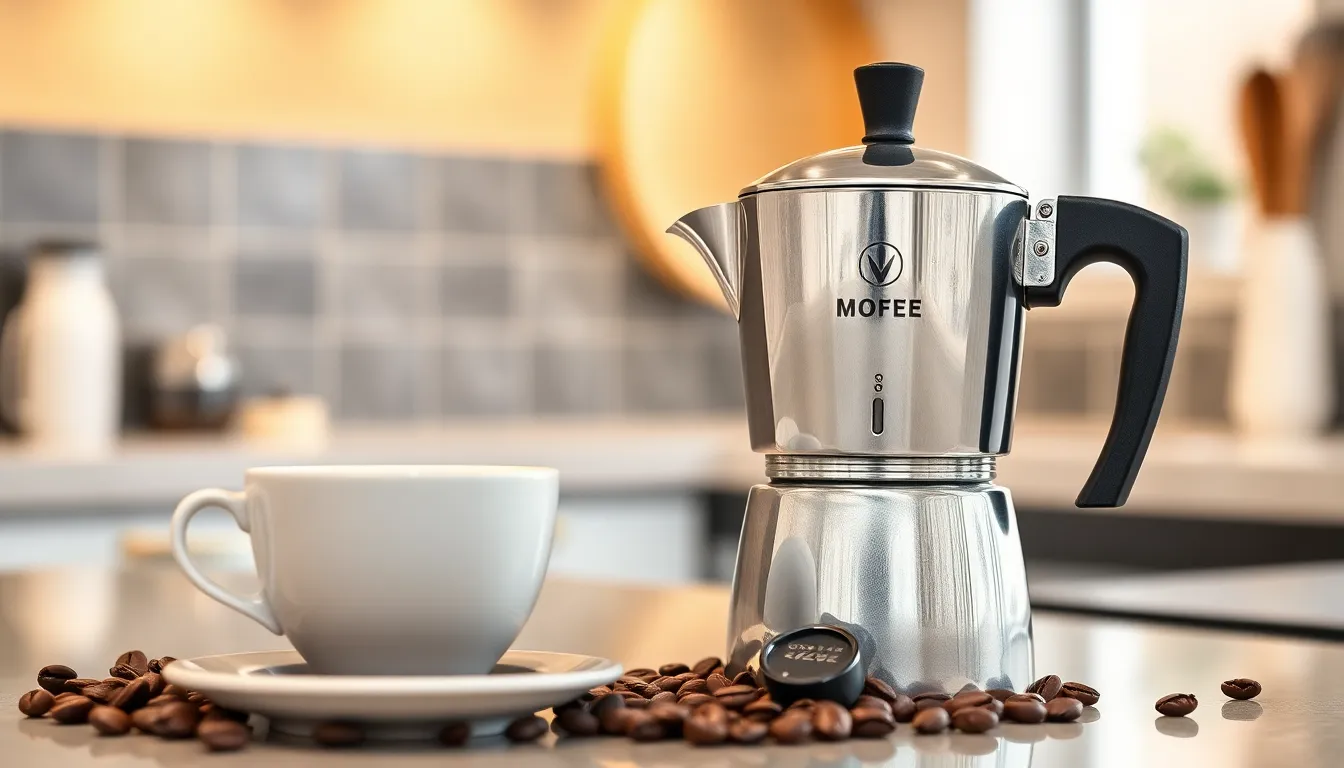
The dishwasher safety of a Moka pot depends entirely on its material composition. Aluminum and stainless steel Moka pots have significantly different care requirements that directly impact their longevity and performance.
Aluminum Moka Pots and Dishwashers
Aluminum Moka pots are not dishwasher safe under any circumstances. These traditional coffee makers feature a delicate surface layer that’s vulnerable to the harsh detergents and high-pressure water jets in dishwashers. Placing an aluminum Moka pot in the dishwasher leads to surface dulling, corrosion, and unsightly white spots as detergents penetrate the protective oxide layer. The damage extends beyond aesthetics – it alters the coffee’s flavor profile and substantially reduces the pot’s lifespan. Dishwasher cleaning can also dislodge the rubber gasket inside the pot due to water pressure, compromising the proper seal needed for brewing. For aluminum models, gentle hand washing with mild soap is the only recommended cleaning method to preserve both function and appearance.
Stainless Steel Moka Pots and Dishwashers
Stainless steel Moka pots are generally dishwasher safe thanks to their robust, nonporous construction. These modern versions withstand dishwasher detergents and cleaning cycles without surface damage or deterioration. The material’s durability makes maintenance significantly more convenient compared to aluminum alternatives. Material quality matters – premium stainless steel models resist dishwasher exposure better than lower-quality alloys. Many titanium Moka pots also feature dishwasher-safe designs, offering similar convenience benefits. A simple magnet test helps identify your pot’s material – magnets stick to stainless steel but not to aluminum, providing a quick way to determine appropriate cleaning methods.
The dishwasher safety distinction between materials creates a clear choice for coffee enthusiasts who prioritize convenience – stainless steel offers significantly easier maintenance while aluminum requires more careful handling to preserve its quality and flavor characteristics.
Risks of Cleaning a Moka Pot in the Dishwasher
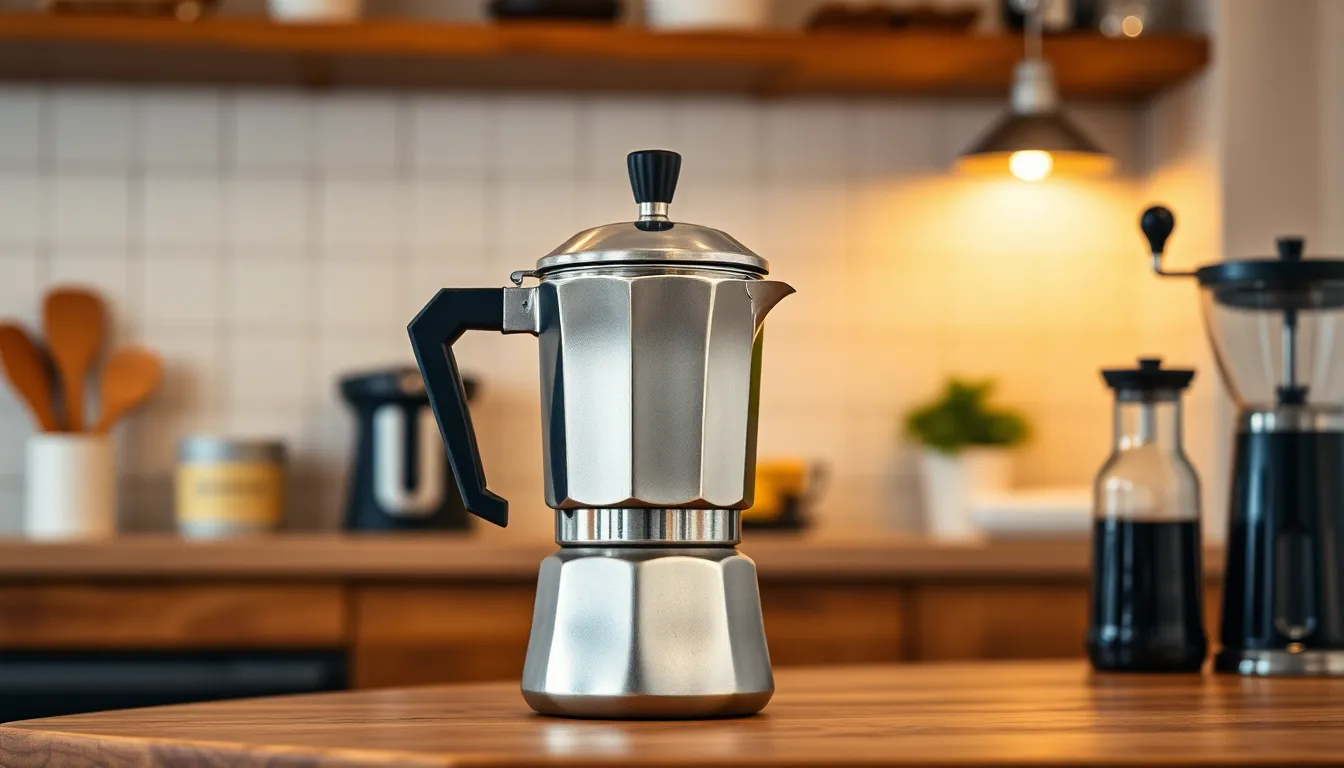
Putting your moka pot in the dishwasher carries important risks that can permanently damage your coffee maker and affect brew quality. The dangers vary depending on whether you own an aluminum or stainless steel model, with aluminum pots facing more severe consequences from dishwasher cleaning.
Corrosion and Discoloration
Aluminum moka pots should never be cleaned in a dishwasher under any circumstances. The harsh detergents and high temperatures in dishwashers attack aluminum surfaces, causing dullness, darkening, and unsightly white oxidation spots. Your pot’s protective anodized layer gets stripped away during dishwasher cycles, exposing the raw metal underneath to extensive corrosion damage. This damage isn’t just cosmetic—corroded aluminum can potentially release metal particles into your coffee over time, creating a potential health concern through long-term exposure.
Stainless steel moka pots offer greater durability against dishwasher cleaning. Their nonporous surface resists corrosion effectively, making them generally dishwasher-safe without the surface damage risks that plague aluminum models. The material’s inherent strength provides protection against the harsh washing environment that destroys aluminum pots.
Damage to Gaskets and Seals
The rubber gasket and seals in your moka pot face serious threats from dishwasher cleaning regardless of your pot’s material. Dishwashers generate powerful water pressure and heat that can shift these critical components out of their proper position. Displaced gaskets compromise the pot’s ability to create a proper seal, leading to leaks during brewing or potentially dangerous pressure buildup.
Gasket damage directly impacts your coffee’s quality by preventing proper extraction. A compromised seal doesn’t allow the moka pot to build the necessary pressure for proper brewing, resulting in weak, under-extracted coffee. More concerning is the safety risk—a damaged seal increases the possibility of pressure accidents during use, where excessive steam buildup could cause the pot to fail catastrophically.
Proper Cleaning Methods for Moka Pots
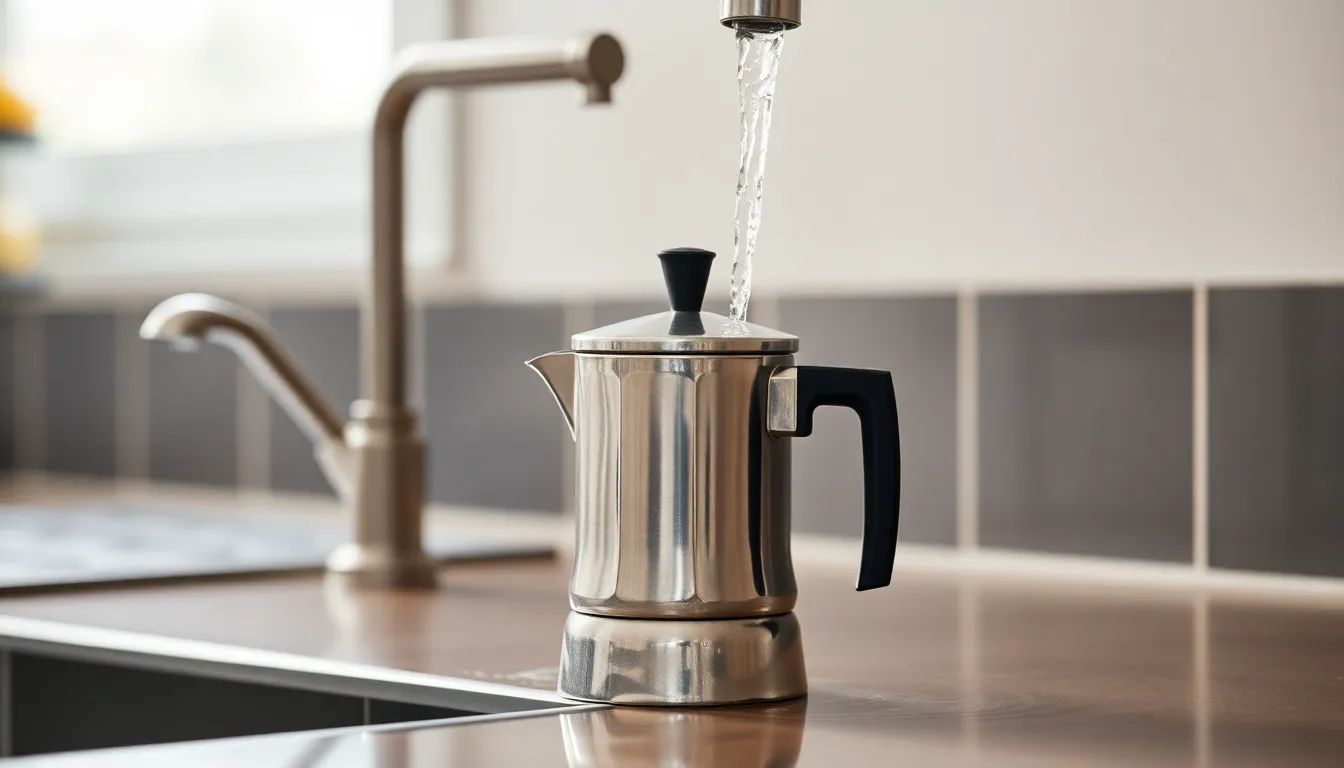
Proper cleaning extends the life of your Moka pot and ensures the best-tasting coffee with each brew. Regular maintenance prevents residue buildup and preserves the pot’s structural integrity, regardless of whether it’s made from aluminum or stainless steel.
Hand Washing Techniques
Hand washing is the safest method for cleaning Moka pots, especially aluminum ones. This gentle approach prevents damage and corrosion that can occur with machine washing. For effective hand washing, apply a small amount of mild dish soap to your pot and rinse thoroughly with warm water. Harsh detergents can damage the surface and potentially lead to aluminum migration, affecting both the pot’s longevity and your coffee’s flavor. After washing, dry the pot completely to prevent water spots and oxidation that might compromise its performance over time.
Removing Coffee Residue and Buildup
Coffee oils and mineral deposits inevitably accumulate inside your Moka pot, requiring periodic deep cleaning. Fill your pot with water and bring it to a boil to loosen stubborn residue from the inner surfaces. For more persistent buildup, create a solution of equal parts water and white vinegar, then let it sit in the pot for several minutes to dissolve mineral deposits. Gently scrub both the interior and exterior with a soft sponge or cloth, paying particular attention to areas with visible buildup. Stainless steel Moka pots may be dishwasher safe according to some manufacturers, but checking exact instructions is essential before machine washing. Aluminum pots should never go in the dishwasher due to corrosion risks and potential aluminum migration. Regular inspection and replacement of the rubber seal, along with filter cleaning, ensures optimal brewing performance and extends your Moka pot’s useful life.
Extending the Life of Your Moka Pot
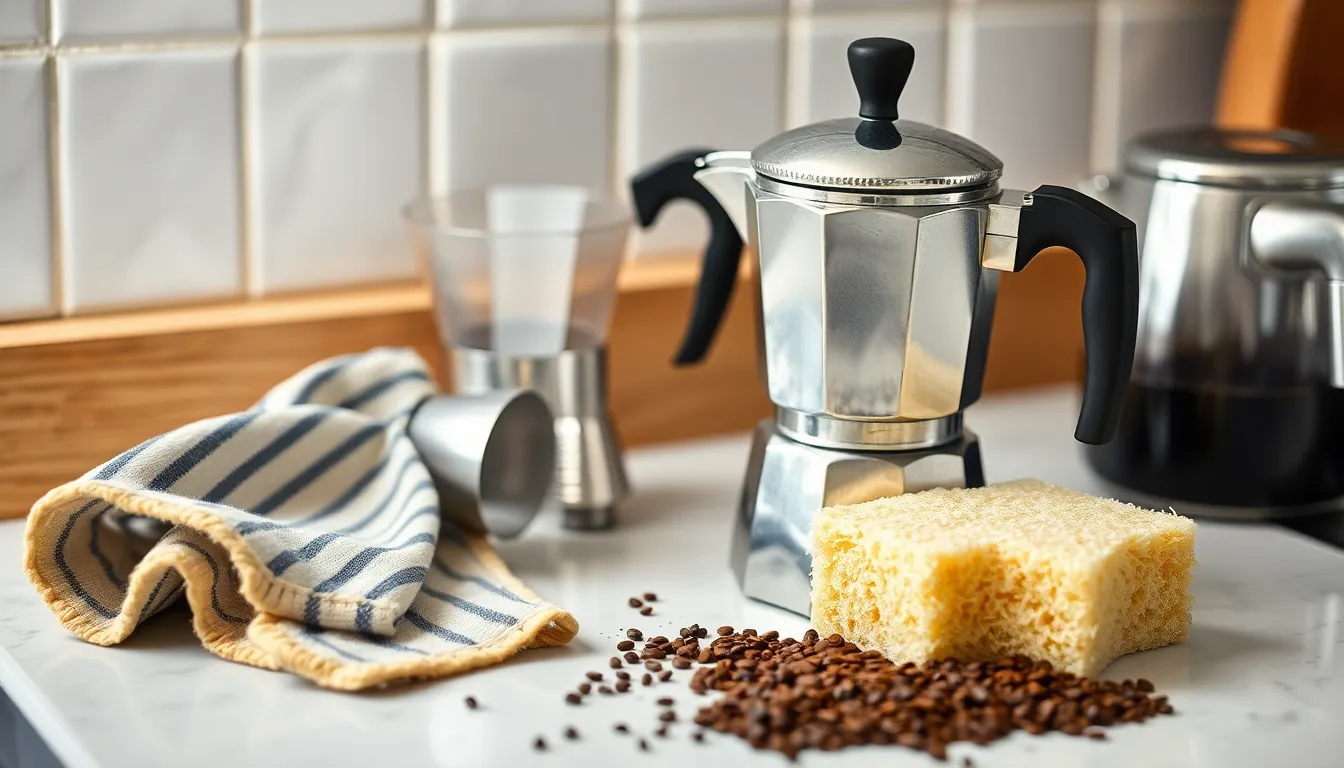
Proper maintenance extends your Moka pot’s lifespan and ensures consistently delicious coffee. Regular cleaning after each use prevents coffee grounds from clogging the safety valve, which can lead to burnt coffee, bland flavor, or even dangerous pressure buildup.
Regular Maintenance Tips
Clean your Moka pot after every brewing session to remove coffee residue that affects taste and function. For aluminum pots, always hand wash all components with mild detergent and a soft cloth to preserve the metal’s integrity. Stainless steel versions require less delicate handling but still benefit from regular cleaning. Check the safety release valve frequently to ensure it’s free from blockages, as this is crucial for safe operation during brewing. The rubber gasket needs periodic inspection for signs of wear, as it maintains the pressure necessary for proper extraction. Scouring the removable filter prevents buildup that can affect water flow and extraction quality.
When to Replace Parts
Replace your Moka pot’s rubber seal when it shows signs of brittleness, cracking, or deformation, as these issues compromise the brewing pressure and lead to leaks. The filter basket requires replacement if you notice corrosion or persistent clogging that thorough cleaning can’t resolve. Your safety valve demands immediate attention if it appears damaged or blocked, as this component prevents dangerous pressure accumulation during brewing. Most manufacturers offer replacement parts for these components, making it cost-effective to maintain your pot rather than replacing the entire unit. Checking these parts before brewing helps avoid unexpected failures that might ruin your coffee routine.
Conclusion
Taking proper care of your Moka pot isn’t just about cleanliness—it’s about preserving the quality of your daily coffee ritual. While stainless steel models offer more flexibility with cleaning methods dishwashers remain a risky choice for aluminum pots.
Hand washing with mild soap remains your safest bet regardless of material type. This simple practice along with regular inspection of gaskets filters and safety valves will keep your Moka pot brewing perfectly for years to come.
Remember that the few extra minutes spent on proper maintenance translate directly to better-tasting coffee and a longer-lasting brewing companion. Your Moka pot will reward your care with rich delicious coffee every morning.
Frequently Asked Questions
Can I put my Moka pot in the dishwasher?
It depends on the material. Aluminum Moka pots should never go in the dishwasher as they can corrode and discolor. Stainless steel Moka pots are generally dishwasher-safe, but their rubber gaskets and seals may still get damaged. For best results and longevity, hand washing is recommended for all Moka pots regardless of material.
How can I tell if my Moka pot is aluminum or stainless steel?
Use a simple magnet test. If the magnet sticks, your Moka pot is likely stainless steel. If it doesn’t stick, it’s probably aluminum. Aluminum pots are typically lighter in weight and may have a duller finish compared to the shinier appearance of stainless steel. The material information is also usually printed on the bottom of the pot or included in the product documentation.
What’s the proper way to clean a Moka pot?
Hand wash your Moka pot with mild dish soap and warm water. Avoid abrasive scrubbers for aluminum pots. For stubborn residue, fill the bottom chamber with water and bring it to a boil, or use a vinegar solution (1:1 ratio with water) for deeper cleaning. Rinse thoroughly, dry completely, and leave disassembled until next use to prevent mold growth.
How often should I replace the rubber gasket in my Moka pot?
Replace the rubber gasket when you notice signs of wear such as cracks, brittleness, or when it no longer creates a proper seal. For most regular users, this means replacing it every 6-12 months. Frequent brewing, heat exposure, and cleaning methods all affect the gasket’s lifespan. Always use manufacturer-recommended replacement parts for the best fit and performance.
Why does my Moka pot coffee taste metallic?
A metallic taste usually indicates improper cleaning or maintenance. This can happen when aluminum pots are dishwasher-cleaned, causing the protective oxide layer to deteriorate. Other causes include using a new pot without “seasoning” it first, mineral buildup, or a worn gasket affecting the brewing process. Hand wash regularly and consider brewing a few “throwaway” batches with a new pot.
How long should a Moka pot last?
With proper care, a quality Moka pot can last decades. Stainless steel models typically outlast aluminum ones, but both can provide years of service with regular maintenance. The most common replacement needs are the rubber gasket and filter, not the pot itself. Many families pass down well-maintained Moka pots through generations, making them both practical brewing devices and sentimental heirlooms.
What’s the difference between Moka pot coffee and espresso?
Moka pot coffee is stronger than drip coffee but not quite espresso. Moka pots generate 1-2 bars of pressure compared to espresso machines’ 9+ bars, resulting in less crema and a different extraction profile. The taste is rich and concentrated but lacks the true espresso texture and intensity. Moka pots offer an affordable home alternative that captures the essence of espresso without requiring expensive equipment.
How do I fix a leaking Moka pot?
Leaking usually indicates a problem with the seal. First, check the rubber gasket for damage and replace if necessary. Ensure the filter plate is properly positioned and not bent. Clean any coffee grounds from the rim where the chambers connect. Check that you’re not overfilling the water chamber or tamping the coffee grounds. Finally, make sure all parts are screwed together tightly but without excessive force.

